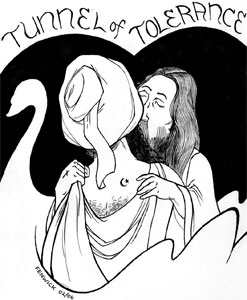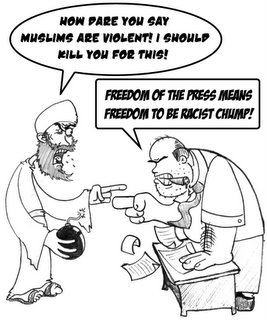Graphics speak louder than words.
To all the CUP papers that have dealt with the cartoons: thumbs-up. I feel like being a little offensive today, perhaps it's the fact that my head isn't connected to my neck, who knows, but anyway here are the CUP cartoons, in all their glory.

The Strand, out of Victoria University at the U of T, recently ran an editorial by Aine O'Hare alongside this cartoon, which garnered a CP story.
"All media, student or otherwise, has a responsibility to its audience. Media should inform, invoke discussion, represent a wide range of ideas and encourage critical thinking.
"However, you can only push an envelope so far before you get a nasty paper cut, one sure to be infected with the gangrene of social unrest."

In the Gateway, Chloé Fedio,writes:
While depicting the prophet is considered idolatrous by any Muslim and against religious practices, the cartoons were created in response to a Danish writer who, for that very reason, faced difficulty finding an artist for his children's book about Muhammad.
Clearly, the cartoons are offensive and comment on the propensity for Muslim activists to use terrorism in the name of religion. One depicts Muhammad with a bomb-shaped turban, while another has him crying out to suicide bombers waiting to be admitted to heaven, "Stop, stop! We ran out of virgins!" But violent protests in reaction to the cartoons are doing nothing but perpetuating this negative stereotype.
Editorial cartoons are generally of a facetious nature, and are certainly not meant to cause hostile diplomatic relations. This is especially so, since an independent press is just that—independent—and shouldn't, in an ideal world, regulate its content based on government influence.

In UNBC's Over the Edge, my good friend Tyler Clarke takes the middle road.
"Needless to say, this example of freedom of speech [or lack thereof] has ignited the media world, who are obviously strong advocates of this right."
And, lastly, from the Peak at SFU:

Accompanied by an editorial by Dock Currie:
"The main reason that these caricatures have gotten reprinted in large press European newspapers, and are now reprinted, in silhouette, in the SFU campus paper, is that censorship of carefully constructed — and legitimate — satire doesn't deserve to take second-class status to the needs of a very vocal faith. Flemming Rose, the cultural editor at Jyllands-Posten, who was responsible for the cartoons in the first place, said it best when he phrased it thusly: 'Religious feelings cannot demand special treatment in a secular society.'"
The Argosy and the Cadre also dealt with the cartoons in their own ways. The Cadre decided to print them to national interest and the Argosy ran two editorials commenting on the social unrest.
Me leave lots of comments today. Me not want to work. Me think you should sleep. Get better that way.
Hope you feel better soon!
W
Ah yes. What's more is that we heard not a single peep from anyone about the cartoon (that you have posted) that ran along with the editoral.
Yes, the Argosy's editorials were very, very well done, and I didn't reprint the Cadre's, for the simple fact that anyone who's reading this has already seen the cartoons and heard that the Cadre reprinted them.
The Toban, a little slow on the uptake, will be running a counterpoint alongside Dave Weatherall's commentary this week.
There will be peeps.